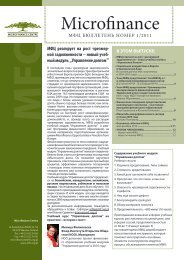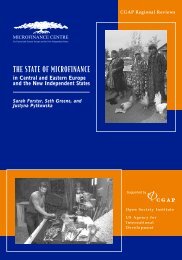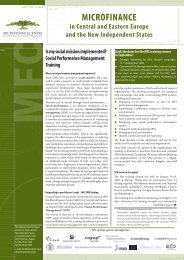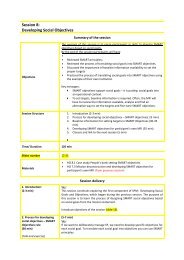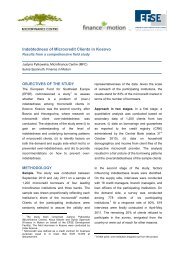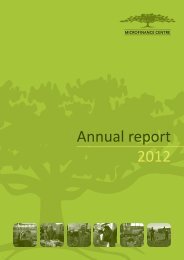Value Chains research report Tajikistan final - Microfinance Centre
Value Chains research report Tajikistan final - Microfinance Centre
Value Chains research report Tajikistan final - Microfinance Centre
Create successful ePaper yourself
Turn your PDF publications into a flip-book with our unique Google optimized e-Paper software.
To transport fresh apricots for export, they are harvested before full ripening to extend<br />
their storage life. If necessary, the temperature in the refrigerated truck can be adjusted,<br />
depending on the estimated time of arrival to the market. If the delivery is delayed, the<br />
storage temperature is lowered to +3 degrees. Wooden and plastic crates are used for<br />
harvesting and pre-cooling the apricots. Exporting in plastic crates is deemed too<br />
expensive, so wooden crates are used for shipment. The crates are produced from May<br />
to September, using local material – popular, not suitable for construction. Apricots are<br />
put in wooden crates covered with gauze, in two or three layers.<br />
The export of fresh apricot from <strong>Tajikistan</strong> has very high potential and currently on<br />
young stage of development. And with considering that the only Russia (second largest<br />
importer of fresh apricot with 34,984 tons 6 ), we could confirm that.<br />
Considering our climate, exports of fresh apricots from <strong>Tajikistan</strong> can be<br />
substantially improved. This requires conducting detailed studies in the expected<br />
destination countries, with the emphasis on wholesale markets. It is also useful to<br />
attend thematic exhibitions.<br />
The bottleneck in this segment is the demand for early fresh apricots which can<br />
be ensured by establishing export channels. The current absence of such channels and<br />
the lack of profitable domestic demand results in the apricots being fed to cattle. Prices<br />
offered by canning factories do not justify the cost of the harvesting and transportation<br />
of apricots. As a result, farmers often reduce the orchards with fresh varieties and plant<br />
other varieties which are more suitable for drying as the demand for dried apricots<br />
exists throughout the year. Increasing the export market and domestic demand for early<br />
apricots can result in increased farmers’ revenue, which can also improve the<br />
profitability per hectare of existing orchards. If exporters guarantee the purchase at<br />
higher prices, the farmers will be willing to produce more early apricots for the market.<br />
5.1.2.Dried Apricots<br />
The Sub-sector Characteristics of Dried Apricots.<br />
The dried fruit market has been established and developing over several<br />
decades; farmers have been studying the intricacies of this business in an attempt to<br />
earn more income. A large share of all apricots grown in <strong>Tajikistan</strong> is dried. The areas<br />
occupied by varieties that can be dried are increasing yearly, unlike the early varieties.<br />
Drying apricots helps farmers increase the storage life and manage this product in the<br />
market. Particularly the population of Isfara and Kanibadam consider this product a<br />
profitable investment, putting money in the crop during the season and selling as the<br />
price increases. The demand for this product is high throughout the year.<br />
In addition to small “unorganized” middle men, which appear and disappear<br />
quickly, there are people (or groups of people 7 ) who became famous in the local and<br />
national market over the last few years. Isfara is a major supplier of dried fruit to the<br />
6 FAO statistics, 2007<br />
7 Referring to groups of people, rather than companies, as these are not officially registered and are acting on the<br />
basis of certificates for private entrepreneurial activities.<br />
21




